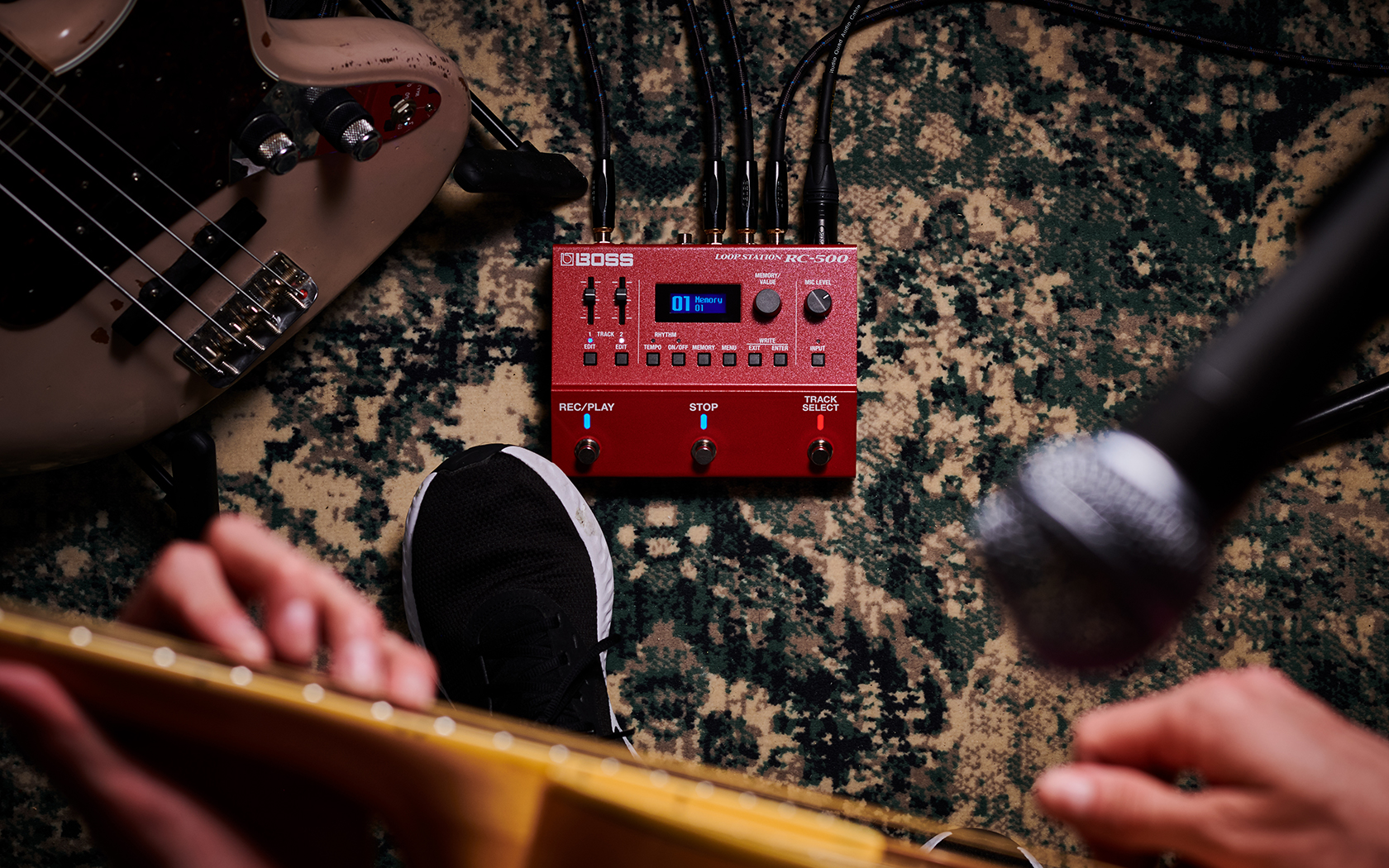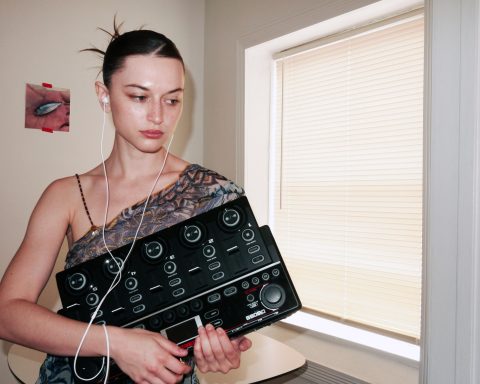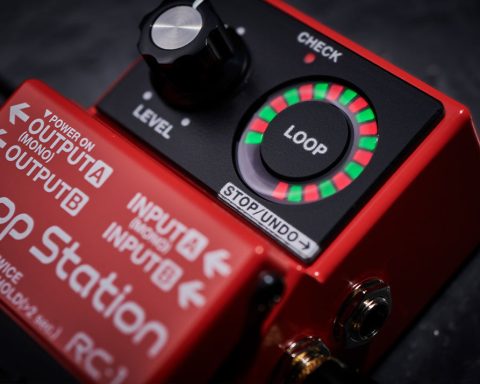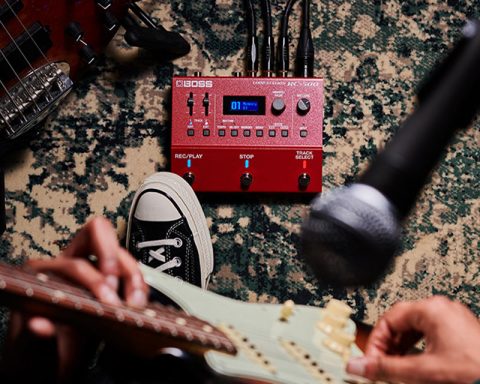Loop pedals with bass open up a world of sonic opportunities, whether you’re laying down a groove to improvise over like Victor Wooten, building full arrangements as a solo performer like Reggie Watts, or making songwriting more enjoyable. At the same time, when you work out your parts, a loop pedal can become an essential tool on your pedalboard. Plus, it can help the artists you’re playing with. Explore everything you need to know about loop pedals for bass players in this comprehensive guide.
Fresh Ideas and Grooves
Many bassists who haven’t used a loop pedal in their bass rig assume these devices repeat phrases, but they do much more. They help develop rhythm, experiment with harmonies, craft melodies, and refine song ideas, all in real time. By layering different phrases and listening as your loop pedal plays them back, you’ll start to hear music in a whole new way, sparking fresh ideas and inspiring new grooves.
Imagine playing with a solo musician or artist running out of ideas. By shifting the harmonic foundation beneath them with a looper, you can guide their phrasing without them even realizing it. Or perhaps you’re using it to explore song arrangements, stacking ideas to let the groove evolve naturally. And that’s just the beginning.
"By layering different phrases and listening as your loop pedal plays them back, you’ll start to hear music in a whole new way, sparking fresh ideas and inspiring new grooves."
If you’re new to looping as a bass player and unsure where to start or which Loop Stations are best to try as part of your bass rig, we’ll guide you through the most common questions bassists have about loop pedals. This article will also explain how loop pedals work, how bass players can use them creatively, and which BOSS Loop Stations are best suited for bass guitar.
Loop Pedals Basics
At their core, loop pedals work on three simple steps:
- Record: You push or “trigger” the footswitch, play a groove, and hit the footswitch at the point you want it to repeat.
- Playback: After pressing the footswitch, the loop immediately repeats, giving you a rhythmic foundation to build. The loop will keep playing, so you can improvise over the top of it.
- Layer: Build on top with more bass lines, harmonics, or rhythmic elements
Pro tip: Loop pedals are an incredible way for bass players to lock in tight grooves, explore different bass runs, harmonics, and riffs, and create some really new bass lines while the original bass line is locking it down. But the key is you need to lock it down first. Make sure to hit the pedal immediately for a seamless loop.
Watch Victor Wooten show how to write a song on bass using a loop pedal.
Floor-Based and Tabletop
There are two types of loop pedals:
- Floor-based loopers: Best for live bassists who need hands-free control. Models like the BOSS RC-1, RC-5, and RC-500 allow hands-free looping as you use your feet to trigger them.
- Tabletop loopers: These are used more by beatboxers and producers, but bassists experimenting with sound design may prefer the BOSS RC-505mkII for its hands-on control and extended memory.
Bassists benefit most from floor-based loopers. Tabletop loopers like the BOSS RC-505mkII are better suited for studio use or beatboxers, but for live bassists, a stompbox-style pedal like the BOSS RC-1, RC-5, RC-10R, or RC-500 is the way to go.
Signal Chain for Bass Looping
For bass players, loop pedals are connected like this. This method means your looped basslines will retain your tone and effects, and you can build a solid foundation for improvisation and song development without muddying your tone.
Bass Guitar → Effects (Compression, Overdrive, Modulation) → Loop Pedal → Amp or PA System
How Do Bass Players Use Loop Pedals?
Creating Live Groove Loops
One of the most powerful ways to use a loop pedal is to establish a repeating groove and add layers. Many bassists start with a simple root groove and then add percussive taps, ghost notes, or harmonics to the loop. The BOSS RC-500 is excellent because it has a dual-track function to record separate sections for a more structured arrangement.
A great loop doesn’t cycle the same bassline indefinitely; it breathes, shifts, and adds depth. Without variation, even the tightest groove can feel static. By using a looper on bass guitar, you can take that groove and start to experiment with subtle changes for each verse.
Developing Melodic and Harmonic Ideas
Bass isn’t just about rhythm. Looping allows you to explore harmonies and melodies, layer chord voicings, lead lines, and counter-melodies over a foundational groove. The RC-5’s high-quality sound processing ensures every layer remains clear and well-defined, making it a great choice for melodic bassists. You can layer multiple tracks and use the onboard LED lights to see where the loop starts and stops.
"Looping allows you to explore harmonies and melodies, layer chord voicings, lead lines, and counter-melodies over a foundational groove."
Expanding Songwriting and Improvisation
Many bassists use loop pedals to develop new song ideas by building sections. A looper lets you hear your composition evolve in real time and discover new arrangements naturally. The RC-10R’s built-in drum patterns add rhythmic variety and help you flesh out your ideas into full-band-style compositions as if you’re playing with a drummer.
Solo Performances
Solo bassists can turn one instrument into an orchestra with a looper. Layering percussive slaps, tapped harmonics, and vocalized effects will give you unique and engaging performances. The BOSS RC-1 is a great entry-level choice for solo bassists who want to start looping with a simple one-button design.
What is the Best Loop Pedal for Bass Players?
There’s no right or wrong answer. It just comes down to the amount of functionality and features you need. But four come to mind as the best bass loop pedals: the RC-1, the RC-5, the RC-10R, and the RC-500 loop pedals.
BOSS RC-1
Ideal for: Beginners to the world of loop pedals who want a simple, reliable looper for bass.
Features:
- 12 minutes of recording time
- Significant loop indicator for easy tracking of loop status
- One-button operation for recording, overdubbing, and playback
- Compact and tough
- Stereo input and output for full-range sound
- External footswitch support for extra control
Why bass players love it: The RC-1 is a no-nonsense looper that lets bassists focus on groove and timing without getting overwhelmed by features. It is good for beginners and is also used by pros who want a simple, solid looper.
"The RC-1 is a no-nonsense looper that lets bassists focus on groove and timing without getting overwhelmed by features."
BOSS RC-5
Ideal for: Intermediate bassists who need more storage, better sound, and built-in rhythms.
Features:
- 32-bit sound processing for clear bass loops
- 13 hours of recording time, 99 memory slots to store loops
- Built-in rhythm guide with 57 presets and seven drum kits
- Color screen for easy navigation
- Reverse and quantize for precise looping
- USB for importing/exporting WAV files
- MIDI for extra control options
Why bass players love it: The high-quality audio means every bass loop sounds clean and defined. With rhythm backing, USB file transfer, and memory slots, it’s great for practice, live performance, and songwriting. Plus, you can import tracks you’re working on and play them through the looper and out of your amp.
BOSS RC-10R
Ideal for: Bassists who need built-in drum patterns and dynamic looping for live shows.
Features:
- Dual track looping with verse/chorus functionality
- Over 280 rhythm styles with two variations per style
- 99 phrase memory slots to save loops
- MIDI compatible for syncing with other gear
- Footswitches for loop and rhythm switching
- Compact size with excellent stereo sound
- Loops and drum tracks volume control
Why bass players love it: The built-in rhythm engine turns the RC-10R into a live monster. It’s like jamming with a full band. The ability to switch between different parts of a song makes it perfect for creating bass parts and arrangements and full band compositions on the fly.
BOSS RC-500
Ideal for: Advanced bassists who need multi-track looping with sound control.
Features:
- Dual stereo tracks with separate controls for complex arrangements
- 32-bit processing for studio-grade bass loops
- XLR mic input with phantom power for vocals or mic’d instruments
- 99 memory slots for storing loops and setups
- Built-in drum machine with many styles and customizable patterns
- MIDI in/out for deep control of external gear
- Three customizable footswitches for hands-free control
- USB for loop storing and backup
Why bass players love it: The RC-500 is a professional loop pedal and one of the industry standards for pro bass layers. Bassists can layer multiple grooves, loop vocal harmonies, and build full arrangements that can become full tracks. The high-quality drum tracks are good for songwriting, and the extensive footswitch and MIDI controls are perfect for live looping and performance.
Why Should Bass Players Use Loop Pedals?
Bass players should use loop pedals for three reasons: build on their grooves, be able to practice bass lines alone, and create unique bass lines with the freedom to experiment. Loop pedals are a fantastic tool for bass because they let you create unique and layered arrangements simply with your bass, and if you have the right pedal, jam along with a drummer.
You can build complete bass grooves and jams on the fly by making them part of your live show. This is perfect if you want to hold down a groove and jam along with your bass lines without distracting the other musicians. Plus, they’re easy to start using. Below are some more benefits:
- Creative Expression: You can experiment with bass lines, harmonies, percussive tapping, and add octave shifts, delays, filters, and more with a looper. You play the original groove and then work over the top of it.
- Live Performance: Loop and build entire grooves on stage, solo, or with a band. Lay down a bassline, add some fills, and play over the top.
- Practice: Practice songwriting, jam freely, and perform without a full band. A looper gives you total control over your sound, and you don’t have to rely on jamming with other musicians.
- Skill Building: Looping challenges your timing, groove, and phrasing. Since any mistakes repeat in the loop, it helps you play tighter and lock in your rhythm.
- Affordability: Loopers are available for every budget, and they’re far more affordable than hiring musicians or using backing tracks. Plus, you can connect your loops to your DAW and use them in recordings or recall them later.
"You can build complete bass grooves and jams on the fly by making them part of your
live show."
Tips for Getting Started with Loop Pedals
Here’s a quick start guide to getting the best sound, starting with a loop pedal on bass.
- Use a Metronome or Rhythm Guide: Timing is necessary for looping, and as a bass player, it’s your job to hold down the groove. So, use a metronome or the built-in drum machines. The RC-5 and RC-10R have built-in drum patterns to help bassists stay on time.
- Start Simple: Focus on tight loops before layering complex melodies or effects. Nail your first loop, then build on that. It all starts with the first loop.
- Control Your Tone: Bass can get muddy with too many layers. Use EQ and compression to keep your loops clear, experiment with octaves where possible, or just switch pickups.
- Practice Footswitch Timing: A well-timed press is key. Tap precisely on the beat to avoid gaps in the loops; otherwise, the whole thing will start to feel off. Master this starting and stopping loop technique; you’ve mastered the most challenging part.
Advanced Looping Techniques for Bass Players
Loop pedals aren’t just for repeating grooves, as discussed here. They can change your entire bass-playing experience and songwriting journey by adding layers and textures you usually might not get to explore. Whether keeping things simple with the RC-1 or building full arrangements with the RC-500, these advanced techniques will help you get the most out of your looper.
Experimenting with Effects
- Chorus and Delay: Add depth to melodic bass loops with built-in effects on the RC-600 or external pedals before looping. Plus, you can save room on your pedalboard.
- Octave and Filters: Use an octave pedal to shift loops up or down for a fuller, multi-layered bass sound while you play the original line over the top.
- Envelope and Modulation: The RC-500’s onboard effects let you sculpt tones for unique textures, from funk-inspired filter sweeps to distorted loops.
"The RC-500’s onboard effects let you sculpt tones for unique textures, from funk-inspired filter sweeps to distorted loops."
Using Drum Tracks to Enhance Groove
- Live Drum Syncing: The RC-10R’s 280+ rhythm patterns provide a built-in drummer to lock your groove and let you get in the pocket.
- Section Changes: Switch between verse and chorus drum parts to create dynamic live arrangements and use dropouts to start and stop loops.
DAW Integration and Importing Loops
- USB Connectivity: Export your recorded bass loops to a DAW for songwriting and production.
- Import Pre-Recorded Loops: Load WAV files into the RC-5, RC-500, or RC-600 to trigger full backing tracks for playing over the top.
- Multi-Track Recording: The RC-600’s six stereo loop tracks can send individual outputs to your DAW for layered loop production—it’s like a recording interface and loop pedal all in one.
Quantizing for Perfect Timing
- Timing Correction: The RC-5’s quantization feature snaps loops into place, ensuring seamless transitions between loops so you don’t have to worry about losing timing when jamming.
- Loop Length Matching: The RC-500’s auto-record function keeps all loop layers aligned, preventing uneven phrasing.
- Rhythm Syncing: The RC-10R automatically quantizes loops to its internal drum machine, eliminating timing drift.
Watch Emily McVicker create bass loops on guitar on the BOSS RC-600 input FX, which shows you how acoustic players use a loop pedal and vocalists and beatboxers can as well.
Frequently Asked Questions about Loop Pedals for Bass Players
Where should I put my looper in my bass pedal signal chain?
The looper pedal should go at the end of your effects chain before the amp or PA. So, all tone-shaping effects are captured in the loop.
Can I use a loop pedal live?
Yes! Many solo bassists and live performers, like Victor Wooten, use loop pedals to build grooves, add melodies, and create soundscapes.
How do I prevent muddiness in my loops?
Avoid excessive low-end layering. Use an EQ pedal to carve space for each looped section, and make sure you play octaves to separate each line.
What are the best Loop Stations for beginning bass players?
The BOSS RC-1 is simple and easy to use, perfect for first-time loopers who want to use a loop pedal on their bass.
Can I use a loop pedal for practice on bass guitar?
Yes. Loop pedals are great for nailing your timing, soloing over grooves, and improving rhythmic phrasing with your bass.
"Whether you’re a beginner learning the basics or an advanced player using multi-track looping, there’s a BOSS Loop Station for you."
Looping Bass for Incredible Grooves
Loop pedals are a must-have for bassists who want to expand their sound, solo performances, and groove. Whether you’re a beginner learning the basics or an advanced player using multi-track looping, there’s a BOSS Loop Station for you. Try one on bass today, create some incredible grooves, and take your bass playing to the next level with looping.
Want to dive deeper into looping? Visit our Loop Station hub for more insights, tips, and resources.






